Glub, Glub
- Share via
Roger Steene is one of the most technically proficient and aesthetically sensitive underwater photographers working today. It’s no surprise, then, that “Coral Seas” includes crisp portraits of brilliantly colored fishes, shy spidery crustaceans and a slew of bizarre creatures “new to science”--all the dazzling, eye-popping images you’d expect from coffee-table books of this sort. Unlike authors of similar books, Steene also provides spectacular photos taken through the lens of a microscope, chronicling, among other wonders, a coral larva’s metamorphosis from a gelatinous blob to a delicately etched flower-like disk ready to blossom into a colony of a million perfect clones.
I was so taken with the luxuriant pictures of Indo-Pacific reefs that I almost overlooked a problem in the book’s brief introduction (the only extended text in “Coral Seas”). There, the author shrugs off any concerns about the fate of coral reefs, dismissing conservationists as liking “to paint a picture of total doom and gloom” and individuals “who would have us believe that the world’s coral reefs are disappearing at a rapid rate.” Yeah, they’re having a few problems here and there, the Aussie photographer goes on to admit. Not to worry; they’ll bounce back. Amazing things, reefs. Tough. Resilient. Plucky. Now, on to the photos!
The trouble is that coral reefs truly are in grave danger. Given the mesmerizing beauty of “Coral Seas,” however, at first I felt positively Grinch-like, upset by what seemed to be a minor misjudgment by the author. But with each perusal, Steene’s role as Pollyanna by the Sea seems more irresponsible. After all, do we really need more pictorial evidence that the most biodiverse marine ecosystem on our planet is home to exquisite and strange creatures? Anyone who has channel-surfed by a few nature programs in the last decade is aware of this fact.
What we desperately need, and what Steene does not provide, is an understanding of the magnitude of the threats facing these underwater Edens. In Southeast Asian mega-cities, raw sewage pours into the ocean, reducing thriving reefs to algae-covered rocks. Impoverished fishermen throughout the world resort to blast and cyanide fishing, depleting reefs of the very fish that Steene so lovingly photographs. Soil eroded from logging operations finds its way into the sea, smothering the coral animals under layers of muck. And these aren’t isolated problems, as Steene seems to believe. A recent study published by the respected environmental group World Resources Institute determined that 58% of the world’s reefs are potentially threatened by human activity. More than 80% of reefs in Southeast Asia, where Steene does much of his diving, are considered at risk.
Given this dire background, one wants to grab Steene by the wetsuit, give him a good shake and yell, “Listen, mate, you take splendid pictures, but you bloody well better pull your head out of the water and pay attention to what’s going on, or your next book will be called ‘The Wonderful World of Algae!’ ” Steene writes that his aim in producing “Coral Seas” was to give the viewer “simple enjoyment.” In this, he succeeds fabulously. He also states that the book is “not intended to be educational.” Here, alas, Steene proves equally successful.
More to Read
Sign up for our Book Club newsletter
Get the latest news, events and more from the Los Angeles Times Book Club, and help us get L.A. reading and talking.
You may occasionally receive promotional content from the Los Angeles Times.










